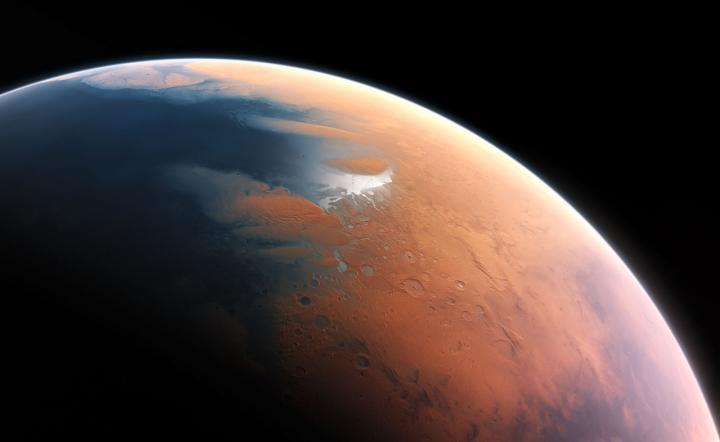An incredible image of Mars has been released that captures the relentless activity of dust devils, swirling across the planet’s surface. These Martian whirlwinds form, move across the surface and dissipate before others take their place. The image was taken by the HiRISE camera aboard NASA’s Mars Reconnaissance Orbiter in September 2022 and shows part of the Haldane Crater, where dust devils have left their mark on the landscape. Scientists study the image tracks and the rate at which dust accumulates on Mars, helping them better understand the planet’s atmospheric processes.
New Image Revealed by NASA of their New Martian Helicopter.
Ingenuity became the first aircraft to fly on another world in the first half of 2021. It explored the Martian terrain from above proving that powered air flight was a very efficient way to move around alien worlds. Now NASA have released a computer rendering of their next design, the Mars Chopper!
Continue reading “New Image Revealed by NASA of their New Martian Helicopter.”NASA Thinks it Knows Why Ingenuity Crashed on Mars

NASA’s Ingenuity helicopter sent its final signals to Earth in the earlier part of the year. Engineers have been studying these and have started to piece together a picture of events that led up to its final flight. They concluded that data provided by the navigation system was inaccurate leading to a chain of events that caused its ultimate demise. One of the biggest problems it seems is that the terrain was smooth leading to a lack of landmarks during Flight 72.
Continue reading “NASA Thinks it Knows Why Ingenuity Crashed on Mars”Martian Clay Could Be Hiding the Planet's Atmosphere

Ages ago in its youth, Mars appeared much like Earth. It was a warm planet with lakes, rivers, and vast seas. It had a thick atmosphere with clouds and rain. One major difference is that the atmosphere was rich with carbon dioxide instead of oxygen. Then about 3.5 billion years ago much of the atmosphere disappeared, and we haven’t understood how. A new study in Science Advances suggests that the waters of Mars may have been the key, and much of the ancient atmosphere may be locked in the surface of the red planet.
Continue reading “Martian Clay Could Be Hiding the Planet's Atmosphere”Mars has an Amazing Variety of Clouds

Mars has always held a special place in our hearts, likely from hints over the decades of perhaps finding signs of life, albeit fossilised and primitive. It’s been the subject of study from telescopes and space missions alike, most notably ESA’s Mars Express which has been observing the red planet for 20 years. Over the two decades of observation it has studied an amazing variety of atmospheric phenomenon which have now been catalogued in a new ‘Cloud Atlas.’ Many will be familiar to sky watchers on Earth but some are very different.
Continue reading “Mars has an Amazing Variety of Clouds”Frost Seen on Olympus Mons for the First Time

It’s been known for years that there are large quantities of water ice locked up in the Martian poles. Around the equator however it is a barren dry wasteland devoid of any surface ice. Recent observations of Mars have discovered frost on the giant shield volcanoes but it only appears briefly after sunrise and soon evaporates. Estimates suggest that 150,000 tons of water cycle between the surface and atmosphere on a daily basis.
Continue reading “Frost Seen on Olympus Mons for the First Time”These Rocks Formed in an Ancient Lake on Mars

We already know that water has existed on the surface of Mars but for how long? Curiosity has been searching for evidence for the long term presence of water on Mars and now, a team of researchers think they have found it. The rover has been exploring the Gale Crater and found it contains high concentrations of Manganese. The mineral doesn’t form easily on Mars so the team think it may have formed as deposits in an ancient lake. It is interesting too that life on Earth helps the formation of Manganese so its presence on Mars is a mystery.
Continue reading “These Rocks Formed in an Ancient Lake on Mars”Planetary Atmospheres: Why study them? What can they teach us about finding life beyond Earth?
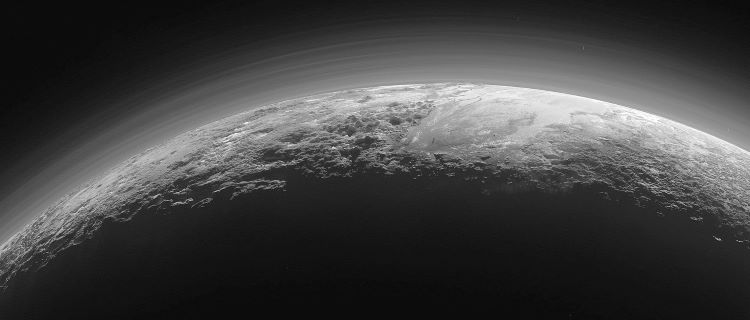
Universe Today has surveyed the importance of studying impact craters, planetary surfaces, exoplanets, astrobiology, solar physics, and comets, and what these fantastic scientific fields can teach researchers and space fans regarding the search for life beyond Earth. Here, we will discuss how planetary atmospheres play a key role in better understanding our solar system and beyond, including why researchers study planetary atmospheres, the benefits and challenges, what planetary atmospheres can teach us about finding life beyond Earth, and how upcoming students can pursue studying planetary atmospheres. So, why is it so important to study planetary atmospheres?
Continue reading “Planetary Atmospheres: Why study them? What can they teach us about finding life beyond Earth?”Life on Mars can Survive for Millions of Years Even Right Near the Surface

Mars is not exactly a friendly place for life as we know it. While temperatures at the equator can reach as high as a balmy 35 °C (95 °F) in the summer at midday, the average temperature on the surface is -63 °C (-82 °F), and can reach as low as -143 °C (-226 °F) during winter in the polar regions. Its atmospheric pressure is about one-half of one percent of Earth’s, and the surface is exposed to a considerable amount of radiation.
Until now, no one was certain if microorganisms could survive in this extreme environment. But thanks to a new study by a team of researchers from the Lomonosov Moscow State University (LMSU), we may now be able to place constraints on what kinds of conditions microorganisms can withstand. This study could therefore have significant implications in the hunt for life elsewhere in the Solar System, and maybe even beyond!
The study, titled “100 kGy gamma-affected microbial communities within the ancient Arctic permafrost under simulated Martian conditions“, recently appeared in the scientific journal Extremophiles. The research team, which was led by Vladimir S. Cheptsov of LMSU, included members from the Russian Academy of Sciences, St. Petersburg State Polytechnical University, the Kurchatov Institute and Ural Federal University.

For the sake of their study, the research team hypothesized that temperature and pressure conditions would not be the mitigating factors, but rather radiation. As such, they conducted tests where microbial communities contained within simulated Martian regolith were then irradiated. The simulated regolith consisted of sedimentary rocks that contained permafrost, which were then subjected to low temperature and low pressure conditions.
As Vladimir S. Cheptsov, a post-graduate student at the Lomonosov MSU Department of Soil Biology and a co-author on the paper, explained in a LMSU press statement:
“We have studied the joint impact of a number of physical factors (gamma radiation, low pressure, low temperature) on the microbial communities within ancient Arctic permafrost. We also studied a unique nature-made object—the ancient permafrost that has not melted for about 2 million years. In a nutshell, we have conducted a simulation experiment that covered the conditions of cryo-conservation in Martian regolith. It is also important that in this paper, we studied the effect of high doses (100 kGy) of gamma radiation on prokaryotes’ vitality, while in previous studies no living prokaryotes were ever found after doses higher than 80 kGy.”
To simulate Martian conditions, the team used an original constant climate chamber, which maintained the low temperature and atmospheric pressure. They then exposed the microorganisms to varying levels of gamma radiation. What they found was that the microbial communities showed high resistance to the temperature and pressure conditions in the simulated Martian environment.

However, after they began irradiating the microbes, they noticed several differences between the irradiated sample and the control sample. Whereas the total count of prokaryotic cells and the number of metabolically active bacterial cells remained consistent with control levels, the number of irradiated bacteria decreased by two orders of magnitude while the number of metabolically active cells of archaea also decreased threefold.
The team also noticed that within the exposed sample of permafrost, there was a high biodiversity of bacteria, and this bacteria underwent a significant structural change after it was irradiated. For instance, populations of actinobacteria like Arthrobacter – a common genus found in soil – were not present in the control samples, but became predominant in the bacterial communities that were exposed.
In short, these results indicated that microorganisms on Mars are more survivable than previously thought. In addition to being able to survive the cold temperatures and low atmospheric pressure, they are also capable of surviving the kinds of radiation conditions that are common on the surface. As Cheptsov explained:
“The results of the study indicate the possibility of prolonged cryo-conservation of viable microorganisms in the Martian regolith. The intensity of ionizing radiation on the surface of Mars is 0.05-0.076 Gy/year and decreases with depth. Taking into account the intensity of radiation in the Mars regolith, the data obtained makes it possible to assume that hypothetical Mars ecosystems could be conserved in an anabiotic state in the surface layer of regolith (protected from UV rays) for at least 1.3 million years, at a depth of two meters for no less than 3.3 million years, and at a depth of five meters for at least 20 million years. The data obtained can also be applied to assess the possibility of detecting viable microorganisms on other objects of the solar system and within small bodies in outer space.”

This study was significant for multiple reasons. On the one hand, the authors were able to prove for the first time that prokaryote bacteria can survive radiation does in excess of 80 kGy – something which was previously thought to be impossible. They also demonstrated that despite its tough conditions, microorganisms could still be alive on Mars today, preserved in its permafrost and soil.
The study also demonstrates the importance of considering both extraterrestrial and cosmic factors when considering where and under what conditions living organisms can survive. Last, but not least, this study has done something no previous study has, which is define the limits of radiation resistance for microorganisms on Mars – specifically within regolith and at various depths.
This information will be invaluable for future missions to Mars and other locations in the Solar System, and perhaps even with the study of exoplanets. Knowing the kind of conditions in which life will thrive will help us to determine where to look for signs of it. And when preparing missions to other words, it will also let scientists know what locations to avoid so that contamination of indigenous ecosystems can be prevented.
Further Reading: Lomonsonov Moscow State University, Extremophiles
Some Earth Life is Ready to Live on Mars, Right Now
For some time, scientists have suspected that life may have existed on Mars in the deep past. Owing to the presence of a thicker atmosphere and liquid water on its surface, it is entirely possible that the simplest of organisms might have begun to evolve there. And for those looking to make Mars a home for humanity someday, it is hoped that these conditions (i.e favorable to life) could be recreated again someday.
But as it turns out, there are some terrestrial organisms that could survive on Mars as it is today. According to a recent study by a team of researchers from the Arkansas Center for Space and Planetary Sciences (ACSPS) at the University of Arkansas, four species of methanogenic microorganisms have shown that they could withstand one of the most severe conditions on Mars, which is its low-pressure atmosphere.
The study, titled “Low Pressure Tolerance by Methanogens in an Aqueous Environment: Implications for Subsurface Life on Mars,” was recently published in the journal Origins of Life and Evolution of Biospheres. According to the study, the team tested the survivability of four different types of methanogens to see how they would survive in an environment analogous to the subsurface of Mars.
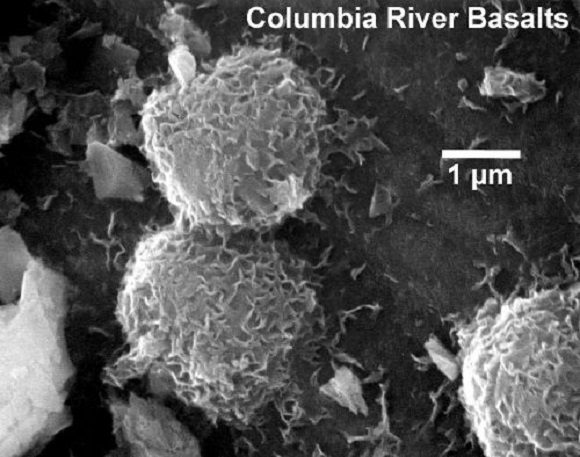
To put it simply, Methanogens are ancient group of organisms that are classified as archaea, a species of microorganism that do not require oxygen and can therefore survive in what we consider to be “extreme environments”. On Earth, methanogens are common in wetlands, ocean environments, and even in the digestive tracts of animals, where they consume hydrogen and carbon dioxide to produce methane as a metabolic byproduct.
And as several NASA missions have shown, methane has also been found in the atmosphere of Mars. While the source of this methane has not yet been determined, it has been argued that it could be produced by methanogens living beneath the surface. As Rebecca Mickol, an astrobiologist at the ACSPS and the lead author of the study, explained:
“One of the exciting moments for me was the detection of methane in the Martian atmosphere. On Earth, most methane is produced biologically by past or present organisms. The same could possibly be true for Mars. Of course, there are a lot of possible alternatives to the methane on Mars and it is still considered controversial. But that just adds to the excitement.”
As part of the ongoing effort to understand the Martian environment, scientists have spent the past 20 years studying if four specific strains of methanogen – Methanothermobacter wolfeii, Methanosarcina barkeri, Methanobacterium formicicum, Methanococcus maripaludis – can survive on Mars. While it is clear that they could endure the low-oxygen and radiation (if underground), there is still the matter of the extremely low air-pressure.
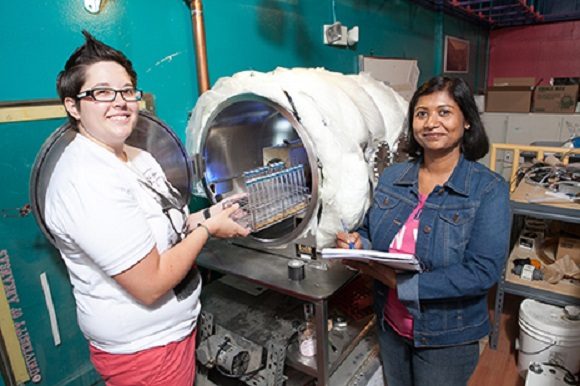
With help from the NASA Exobiology & Evolutionary Biology Program (part of NASA’s Astrobiology Program), which issued them a three-year grant back in 2012, Mickol and her team took a new approach to testing these methanogens. This included placing them in a series of test tubes and adding dirt and fluids to simulate underground aquifers. They then fed the samples hydrogen as a fuel source and deprived them of oxygen.
The next step was subjecting the microorganisms to pressure conditions analogues to Mars to see how they might hold up. For this, they relied on the Pegasus Chamber, an instrument operated by the ACSPS in their W.M. Keck Laboratory for Planetary Simulations. What they found was that the methanogens all survived exposure to pressures of 6 to 143 millibars for periods of between 3 and 21 days.
This study shows that certain species of microorganisms are not dependent on a the presence of a dense atmosphere for their survival. It also shows that these particular species of methanogens could withstand periodic contact with the Martian atmosphere. This all bodes well for the theories that Martian methane is being produced organically – possibly in subsurface, wet environments.
This is especially good news in light of evidence provided by NASA’s HiRISE instrument concerning Mars’ recurring slope lineae, which pointed towards a possible connection between liquid water columns on the surface and deeper levels in the subsurface. If this should prove to be the case, then organisms being transported in the water column would be able to withstand the changing pressures during transport.
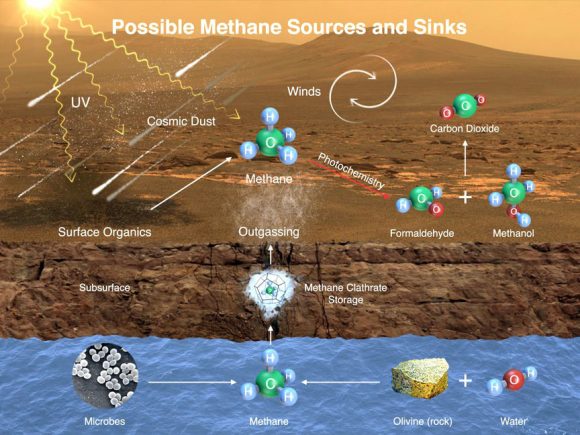
The next step, according to Mickol is to see how these organisms can stand up to temperature. “Mars is very, very cold,” she said, “often getting down to -100ºC (-212ºF) at night, and sometimes, on the warmest day of the year, at noon, the temperature can rise above freezing. We’d run our experiments just above freezing, but the cold temperature would limit evaporation of the liquid media and it would create a more Mars-like environment.”
Scientists have suspected for some time that life may still be found on Mars, hiding in recesses and holes that we have yet to peek into. Research that confirms that it can indeed exist under Mars’ present (and severe) conditions is most helpful, in that it allows us to narrow down that search considerably.
In the coming years, and with the deployment of additional Mars missions – like NASA’s Interior Exploration using Seismic Investigations, Geodesy and Heat Transport (InSight) lander, which is scheduled for launch in May of next year – we will be able to probe deeper into the Red Planet. And with sample return missions on the horizon – like the Mars 2020 rover – we may at last find some direct evidence of life on Mars!
Further Reading: Astrobiology Magazine, Origins of Life and Evolution of Biospheres



